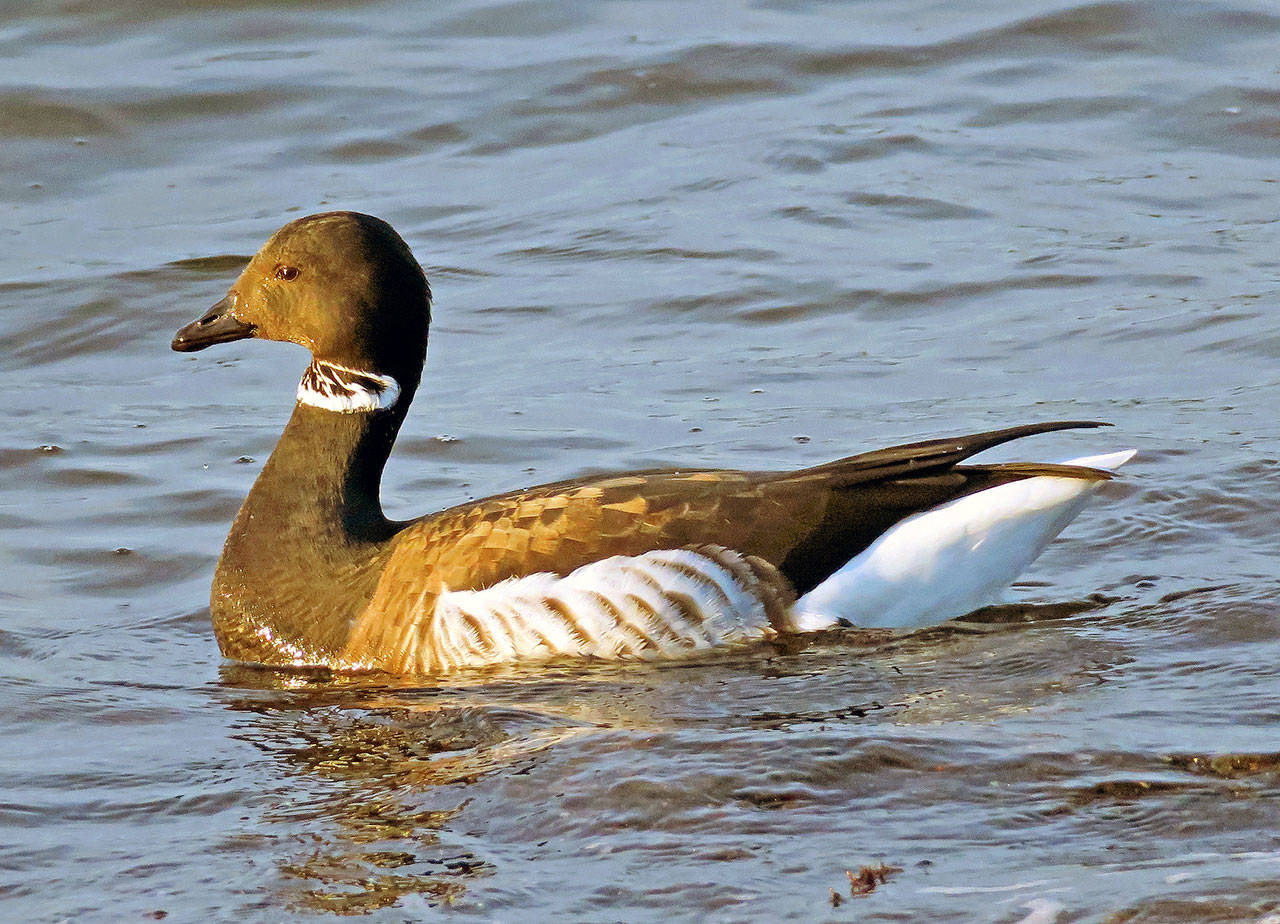By Dianna Moore
Grays Harbor Audubon Society
I like geese and I particularly like the Brant or Black Brant as it is sometimes called out here. The Black Brant name is for the Pacific sub-species. I had only lived in the Pacific Northwest a few weeks when I saw my first Brants off the end of Damon Point in Ocean Shores, a raft of nine birds. I was impressed with their beauty and grace and consider them one of the regions best-looking birds. This fine-looking goose was photographed by Mike Hamilton.
General description: The Brant is a small, compact goose with a short black bill, black head, neck and chest, and a broken white collar high on the neck. Both sexes look alike while the immature goose lacks the white collar and has scaling on its back. They are 22 to 26 inches in length, with wingspans of about four feet, and weigh between two and five pounds. The Pacific version has more white on its sides than the Atlantic goose.
Habitat: This goose is almost exclusively a coastal resident of shallow bays and saltwater marshes. Their winter habitat depends on the presence of sea grasses and marine algae and they nest in the wet, coastal tundra of the high Arctic. No other goose nests as far north and few migrate as far.
Behavior: Brants are usually found in a flock. They forage as they wade or tip up in shallow water, or as they walk the tidal flats or shoreline. They are fast fliers with swept-back wings and they may fly as high as several thousand feet during migration. They display strong site-fidelity to both their wintering and nesting areas.
Diet: Brant have historically fed almost exclusively on eelgrass but will also eat wigeon grass, rock grass and green algae. On summer breeding grounds they eat sedges, grasses and pondweed and some invertebrates, mollusks and aquatic insects. Their range is still closely tied to eelgrass.
Nesting: Pair bonds form on the wintering grounds. Usually nest in colonies within one to five miles of the coast. The nest is usually on a small island in a tundra pond or a slight rise on the tundra, made of grass and other available vegetation and heavily lined with down. The female incubates three to five eggs for 22 to 24 days. The young leave the nest within 24 hours of hatching, with both parents guiding them to food sources and guarding them from harm. During the long days of the arctic summer, the young feed at all hours and grow quickly. They fledge at 40 to 50 days, but stay with the parents through the first migration.
Migration: The west coast population breeds primarily on Melville Island and Prince Patrick Island in the western high Arctic. They leave their breeding grounds and stage at Izembek Lagoon for approximately a month before heading south to over-winter from Alaska to Baja. A staggering 90 percent spend the winter in Baja. Brants return to their summer grounds later than most geese because of the longer winter on the upper reaches of the continent.
Conservation status: Brant are vulnerable to breeding failure and heavy loss from starvation due to their dependence on eelgrass in particular. The population is now stable after a long-term decline, but their northern breeding grounds are sharing space with the burgeoning petroleum industry, and Izembek National Wildlife Refuge is being threatened by a road. Izembek NWR is home to some of the best eelgrass beds. Meanwhile on the southern end of their journey, the geese used to be scattered up and down the Pacific but were made to feel unwelcome, hence the large percentage in one area.
When and where to find on Grays Harbor: Brant can be found on the outer coast between November and early May. I mentioned seeing them off the northeast end of Damon Point, though not for a few years. I have also seen them on the beach here in Ocean Shores and up to Conner Creek in Copalis Beach. If you know where there is a good patch of eelgrass, look there. They are worth the effort.


